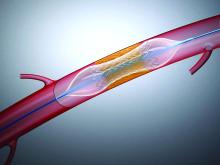The American College of Cardiology, the American Heart Association, and the Society for Cardiovascular Angiography and Interventions (SCAI) have jointly issued new guidance outlining competency-based advanced training requirements for interventional cardiology trainees.
It’s the first document of its kind to define the training requirements for the full breadth of interventional cardiology for adults, including coronary interventions, peripheral vascular interventions (PVIs), and structural heart interventions (SHIs), the organizations say.
“With this groundbreaking document, the writing committee provides a roadmap for both program directors and interventional cardiology trainees to help them progress through important training milestones,” Theodore A. Bass, MD, chair of the statement writing committee, says in a news release.
“The document defines the required competencies for the full scope of interventional cardiology, providing trainees for the first time with the information to support training across all these areas,” Dr. Bass adds.
Minimum of 250 procedures
To gain the necessary experience in interventional cardiology, cardiovascular fellows are advised to complete the following:
- A 3-year general cardiovascular disease fellowship (successful completion consists of Level I competency in all aspects of cardiovascular medicine and Level II competency in diagnostic cardiac catheterization to pursue interventional cardiology training);
- A 1-year accredited interventional cardiology fellowship, the focus of which is coronary intervention with the opportunity to gain procedural experience in various aspects of PVI or SHI (Level III competency);
- An option for additional post-fellowship training based on the trainee’s career goals.
The goal of Level III training is to provide the interventional cardiology trainees with a “well-rounded, competency-based education,” including didactic instruction, clinical experience in the diagnosis and care of patients, and hands-on procedural experience, the writing group says.
Competency requirements are defined using the Accreditation Council for Graduate Medical Education’s six “essential” competency domains: medical knowledge; patient care and procedural skills; practice-based learning and improvement; systems-based practice; interpersonal and communication skills; and professionalism.
To support attaining these competencies, the writing committee recommends a minimum of 250 interventional cardiology procedures. Of these, 200 should be coronary procedures, with the remaining 50 specialized in coronary, PVI, or SHI, which allows the fellows to customize training on the basis of their career goals.
Adjunctive procedures related to physiologic assessment and intracoronary imaging are also required (25 of each). “These minimum numbers are meant to provide trainees with exposure to a variety and spectrum of complexity of clinical case material and give supervising faculty sufficient opportunity to evaluate trainees’ competency,” the writing group says.
In addition to their procedural skills, evaluation of interventional cardiology trainee proficiency should include regular assessment of a trainee’s ability to clinically diagnose and manage patients across the broad spectrum of diseases.
Assessment of trainees should involve multiple components, including direct observation by instructors, case logs, chart reviews (including adherence to guideline recommendations, appropriate use criteria, and patient outcomes), simulation training, and assessment of leadership skills.
Trainees must also acquire experience working as part of a multidisciplinary team to provide a holistic approach to patient care. The document also highlights the importance of leadership skills, mentorship and lifelong learning beyond initial training.
The 2023 ACC/AHA/SCAI Advanced Training Statement on Interventional Cardiology (Coronary, Peripheral Vascular, and Structural Heart Interventions) was published online in the Journal of the American College of Cardiology.
The statement was developed in collaboration with and endorsed by the American Association for Thoracic Surgery, the American Society of Echocardiography, the Heart Failure Society of America, the Heart Rhythm Society, the Society of Cardiovascular Anesthesiologists, the Society of Cardiovascular Computed Tomography, the Society for Cardiovascular Magnetic Resonance, the Society of Thoracic Surgeons, and the Society for Vascular Medicine.
A version of this article first appeared on Medscape.com.


